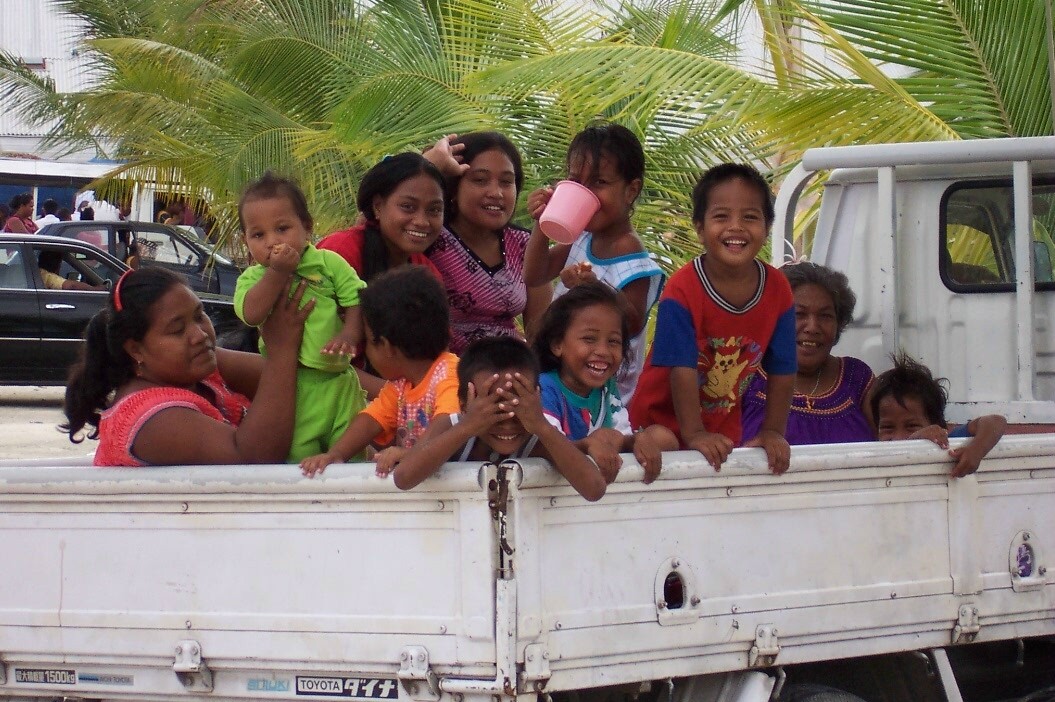There was a touch of anxiety in the air as we lifted off for Bonriki. We had been promised Avgas on the island but it was not as simple as to fly in and tank up. The owner of the Avgas was in Australia and impossible to contact. His assistant was in Portland, Oregon and very difficult to reach. In addition, their staff at Bonriki did not know the octane rating of the gas. When we received the faxed landing permit from the airport, a message was attached from the airport manager stating that the only two men with keys to the Avgas supply container were the two out of the country. Moreover, we had only enough gas to fly to either Majuro or Bonriki but not to both islands.
We felt we could take a calculated risk, however, that one of the wives would have a key. Then, if the Avgas was of incorrect octane, we could possibly pump a small amount into one of our internal tanks and, while it may not be suitable for takeoff or landing, it could be utilized at the reduced power settings of cruise altitude. That would get us to Majuro. A ferried 727 will go through Majuro in about a month and carry fuel for us, if necessary, so that was the failsafe backup plan.
There was a fairly dense overcast nearly the entire flight. Overcasts make it difficult to communicate by HF (high frequency) radio. There is also a great deal of static on HF but it is the only suitable medium for long distance communication. We had reasonable contact with San Francisco for the first half of the flight but had none for most of the last half. Moreover, there were very few other aircraft on our route so our position reports could not be relayed. This is a common occurrence so they don't send out Search and Rescue simply because one misses a few position reports. Your endurance is listed on the flight plan when it is filed and that time would determine when they would start to become nervous. You just keep trying to reach someone. We tried just about every frequency except for the CB channels but could not reach anyone. When we were about 150 miles from the destination, however, radio contact was made with the airport and all was well again.
The airport is at the south side of the island so the approach was very scenic. This island is essentially a coral reef. Colors of the water change with the varying depths and much of the surrounding waters are quite shallow. Crayola may have name for all of them but we were not even aware there were so many shades of aquas, blues and teals.
When we taxied in, there were 3 people working in a large shipping container. It turned out that they were removing empty Avgas drums to get to full ones behind. The good news was that they had been expecting us and obviously had the key to the container. Even better, the fuel was rated at the required 100 Octane and they were ready to pump it as soon as we cleared customs and immigration. We filled the tanks nearly to the top but waited until the next evening to top them off for the long flight to Hawaii. The hot sun expands gasoline and, if the tanks are totally full, gas spills out of the overflow drains in the heat of the day. We would wait until the sun was down and cooler temperatures prevailed to get in every gallon possible for that flight.
Bonriki, Kiribati was formerly known as Tarawa. It was the site of major battles during World War II, many Marines lost their lives before securing the island. It is now home to about 24,000 happy residents. Only about 15 miles long and with one road, you can drive from one end to the other in under an hour. Much of the time, you can see water on both sides.
We met a man from Australia at dinner and he loaned us his car to "Look about." We drove with him to his office the next morning, dropped him off and left from there. There are homes and businesses along all the entire road. People are laidback and smile a lot. No one seems to be in a hurry except for the drivers of the many small busses that traverse the road in both directions.
When we returned his car later that day, he explained that he had business in the opposite direction from the hotel and that we would get back more quickly if we took a bus. That was a memorable experience! The busses are actually 10 passenger mini vans but as many as 20 can squeeze in if necessary. Whenever someone needs to get out, several others must exit first and then re-board. It always appears that many passengers are getting off the bus but usually, there is only one.
We waited for a bus that looked somewhat empty and flagged it down. Seemingly out from nowhere, a few other passengers appeared as well. One had a small cardboard box containing a few fish protruding from both top and bottom. There were also many flies darting about. She had to sit right next to us. We quickly opened every window within reach as far as it would go and she helped us chase away all the flies as the bus picked up speed. The flies were no match for the bus and quickly were outdistanced. However, a few miles down the road, the driver suddenly darted into a driveway and stopped to refuel. That gave the flies all the chance they needed to catch up. Fortunately, someone else got off and the woman took a seat farther away from us. Life is good!
